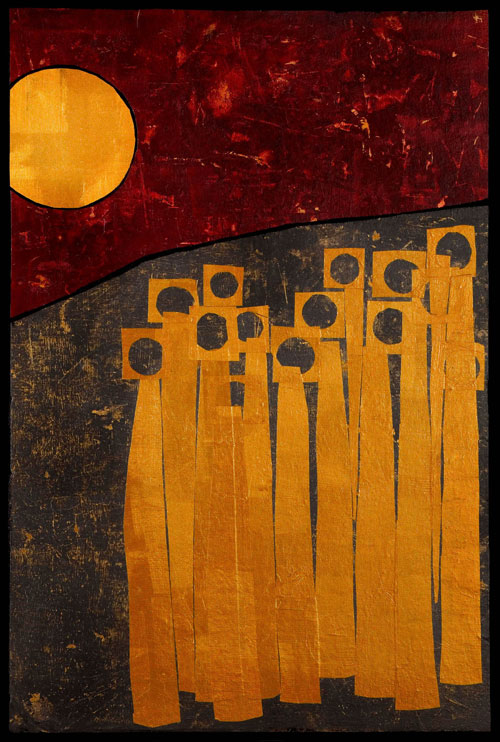A blessed Brigid’s Day to you! February 1 is one of my favorite days on the calendar: the Feast of St. Brigid of Kildare, the beloved Irish saint. Born in the middle of the 5th century, Brigid became a powerful leader of the early church in Ireland. She established a number of monastic communities around Ireland, the most famous of which was the double monastery (including both women and men) of Cill Dara (“The Church of the Oak”), now known as Kildare.
The earliest piece of writing about Brigid—a text called “Ultan’s Hymn” that dates to perhaps the 7th century—refers to Brigid as a “golden, sparkling flame.” The presence of fire pervades her stories, testimony to the sacred power that permeated her life.
Renowned for her hospitality (“Every guest is Christ,” Brigid said), she had a remarkable gift for welcoming others. The ancient stories about Brigid are attended by the miraculous: in the face of hunger, illness, and injustice, or the simple lack of something that would complete a feast, Brigid worked wonders by which people received what they needed, whether it was the filling of hunger, or healing, or being set straight—or having all the makings for a festive meal.
For centuries, Brigid has enchanted the imaginations of folks both within and beyond Ireland. A compelling woman in her own right, Brigid’s enduring popularity owes something as well to the fascinating legends that have accumulated around her. Some of my favorite tales are those that place Brigid at the birth of Christ, calling her the midwife to Mary and the foster mother of Jesus—an honored role in Celtic society. So great was Brigid’s power, evidently, that it could extend even to time as she slipped backward across centuries in order to be present for the birth of the Christ whom she loved completely.
Brigid’s appeal is connected also with the fact that her stories and symbols resonate with those of a Celtic goddess named Brigid, who was described as a goddess of healing, poetry, and smithcraft. Although it’s often assumed that Brigid the goddess simply put on a Christian cloak to become Brigid the saint, it’s quite possible that it worked in the opposite direction. Scholar Lisa Bitel suggests that those who were writing down the stories of Brigid the saint drew upon the nexus of symbols, powers, and qualities of the pre-Christian Celtic goddesses, in order to underscore her miraculous abilities with imagery that would have been familiar to that culture.
It’s not really important just how the evolution of Brigid took place: what emerges from the intertwining of history and legend is a remarkable woman who continues to intrigue and to inspire. Brigid helped to transform the landscape of early Christian Ireland, and continues to exert her transforming power now.
One of Brigid’s legacies is a present-day community that takes its name from her. More than a decade ago, Mary Stamps established Saint Brigid of Kildare Monastery, a community that draws from both Methodist and Benedictine traditions. Brigid was known as a bridge-builder and a threshold figure, symbolized in the story that tells that her mother, Broicsech, gave birth to her as she crossed through the doorway into her house. This threshold, bridge-building quality imbues the monastery that bears Brigid’s name.
Mary Stamps is a longtime friend, and I’ve been part of Saint Brigid’s since its early days. It is one of the great gifts in my life. Saint Brigid’s is made up of women and men, both single and married, lay and clergy. We stretch across the United States and into the Dominican Republic, finding creative ways to tend our life together.
You can find out more about the community at Saint Brigid of Kildare Monastery. I’m also pleased to report that Mary has finally knuckled under and recently started a blog, which you can visit at RB 72.11. (The blog’s title is a reference to a verse of the Rule of Benedict in which he writes, “Let us prefer nothing whatever to Christ.”)
To celebrate tomorrow’s feast day, here’s a blessing in honor of Brigid. It’s from In the Sanctuary of Women and appears in the chapter titled “A Habit of the Wildest Bounty: The Book of Brigid.” I loved the research and questioning, pondering and praying that were involved in working on her chapter, following the threads both ancient and new that link her story with our own. Brigid, that “golden, sparkling flame,” beckons us deeper into the fire and the mystery of God. And that is worth a day of celebration, and then some.
May the power of Brigid inspire you,
the grace of Brigid attend you,
the flame of Brigid enliven you,
the story of Brigid engage you.
May the God who provided her all these gifts
provide them also to us,
that we may go into the world
with her lavish generosity
and her creative fire.
A blessed Feast of St. Brigid to you!
 P.S. I’m delighted to share the news that my book Night Visions has just come back into print. Who says a book for Advent and Christmas doesn’t make a great Valentine’s Day gift? For info and to order, visit the Books page on my main website. And for a previous reflection on St. Brigid, see A Habit of the Wildest Bounty: Feast of St. Brigid at my blog The Painted Prayerbook.
P.S. I’m delighted to share the news that my book Night Visions has just come back into print. Who says a book for Advent and Christmas doesn’t make a great Valentine’s Day gift? For info and to order, visit the Books page on my main website. And for a previous reflection on St. Brigid, see A Habit of the Wildest Bounty: Feast of St. Brigid at my blog The Painted Prayerbook.







